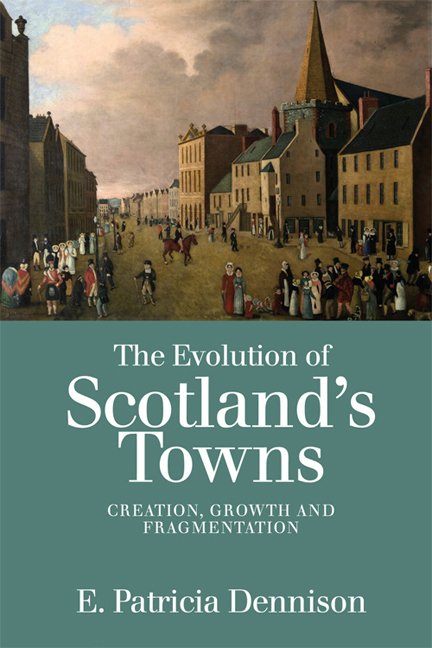Book contents
- Frontmatter
- Contents
- List of Figures
- Acknowledgements
- Image Credits
- List of Abbreviations
- Introduction
- 1 Medieval Towns
- 2 Daily Life in the Middle Ages
- 3 Medieval Faith and the Church
- 4 Encroachment on Burgh Society, 1550–1750
- 5 Man-made and Natural Disasters, 1550–1750
- 6 The Birth of Urban Scotland
- 7 The Victorian Town
- 8 The Twentieth Century
- Post-script: Footprints to Fragmentation
- Appendix: Population Statistics – A Select List
- Bibliography
- Index
Post-script: Footprints to Fragmentation
Published online by Cambridge University Press: 11 November 2020
- Frontmatter
- Contents
- List of Figures
- Acknowledgements
- Image Credits
- List of Abbreviations
- Introduction
- 1 Medieval Towns
- 2 Daily Life in the Middle Ages
- 3 Medieval Faith and the Church
- 4 Encroachment on Burgh Society, 1550–1750
- 5 Man-made and Natural Disasters, 1550–1750
- 6 The Birth of Urban Scotland
- 7 The Victorian Town
- 8 The Twentieth Century
- Post-script: Footprints to Fragmentation
- Appendix: Population Statistics – A Select List
- Bibliography
- Index
Summary
Scotland has entered a new millennium. The past one has brought profound changes for the country's towns. Disease, war, foul weather, neglect, misunderstanding and, at times, greed have all taken their toll. But towns have survived. The seeds of our twenty-first-century towns were first footprints when urban society was created; they can be traced as they germinated and grew, some withering and struggling to survive, others maturing and flourishing. Within these evolving footprints are embedded many constants. The aims and ideals, as far as we can interpret them, of the early townspeople run almost seamlessly, but often in differing guise, throughout the centuries of town life until the present day. What are these constants, and have they flourished or withered? What is being handed on to Scotland's children and grandchildren – the politicians, architects, planners, teachers, social workers, priests, gardeners and builders – the decision-makers of the future?
Memory has always played an important part in town life. Medieval annals may not have reached the ordinary man; they were an important record of the past for the very few educated and privileged. But gossip around the fireside on a dark night, or at the local inn, kept alive tales from the past. From the seventeenth century there has been a worthy desire amongst local historians to write their ‘town's history’. By the early nineteenth century, amidst often bewildering change, local histories had become a quest for identity. The search for an understanding of the past is seen to this day in the well-supported local historical societies and heritage trusts. The twenty-first century, amidst another multiple fragmentation of urban life, has seen a vogue of history writing of a fast-disappearing identity: ‘lost’ Aberdeen, Dundee, Edinburgh and Glasgow bestrew publishers’ catalogues. Alternatively, albums of old photographs chart the physical disappearance of the built heritage in smaller towns. The focus of these works is mostly on the changing townscape, but reactions to them, in the form of blogs or online comments, can put some human flesh on the bones of architectural losses and changes. Blogs have been taken to an institutional level by Historic Environment Scotland, backed by Heritage Lottery funding, with Scotland's Urban Past: your town, your street, your story.
- Type
- Chapter
- Information
- The Evolution of Scotland's TownsCreation, Growth and Fragmentation, pp. 291 - 298Publisher: Edinburgh University PressPrint publication year: 2017

